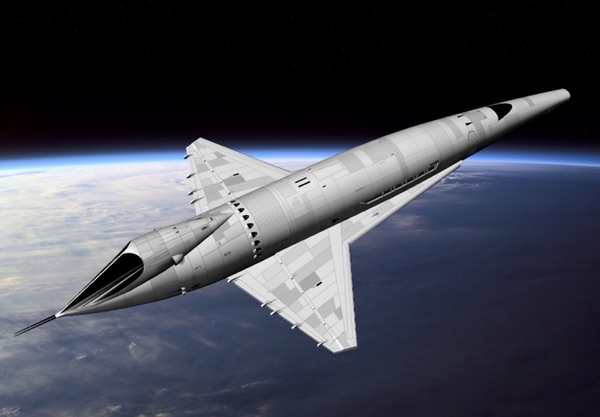Solving the commercial passenger spaceflight puzzle (part 3)by Mike Snead, P.E.
|
| Air Force support for human military spaceflight has waxed and waned since the late 1940s. |
I thought I could best answer the question of why so little had happened by starting with a common point of reference. I asked if they had ever seen the movie 2001 as I was going to mention the famous scene of the Orion III spaceliner and talk about the lack of commercial passenger spaceflight a generation after it “should” have existed. Responding to my question about seeing the movie, I was asked if this was another Apollo movie. This millennial had never even heard of 2001: A Space Odyssey. Others I have spoken with assert that Dr. Floyd’s peaceful ride into orbit aboard the Orion III spaceliner is decades in the future—with an implied “if ever.”
In Part 2, I related how around 2002 NASA had the opportunity to replace the Space Shuttle with a better system. The Air Force—primarily the Wright-Patterson Air Force Base (Wright-Patt) contingent where I worked—and the NASA Marshall Space Flight Center were tasked to evaluate jointly developing a fully-reusable, two-stage-to-orbit (TSTO), vertical-takeoff, horizontal-landing (VTHL) spaceplane system. This was essentially what the Space Shuttle was originally meant to be back in 1970. Eventually, after months of meetings, using its well-developed bureaucratic finesse, NASA turned this opportunity down. In early 2003, Columbia and its crew were lost during reentry due to NASA’s intransigence, across decades, to fix a known flight safety hazard. The post-incident politics threw the fully-reusable opportunity into the trash can of history as NASA fought to keep the shuttle flying.
The situation with the Air Force has not been much better. Air Force support for human military spaceflight has waxed and waned since the late 1940s. In 1948, just one year after separating into a separate service, space and satellites emerged as an area of focus by the Vice Chief of Staff. This was viewed as a manned effort. “Rocketing into space without men on board was as unthinkable to the Air Force as conquering the sea without sailors was to the Navy, or the conquest of the continents without soldiers might have been to the Army.” [1] Just seven years later, a young major working on the first Air Force ICBM program quite vocally expressed his view of the Air Force’s fledgling first spaceplane project, Dyna-Soar: "We wouldn't give you a wooden nickel for your damned winged, boost-glide bomber concept. The Intercontinental Ballistic Missile is the ultimate weapon!" [1] And so it has gone ever since, with echoes of these sentiments embedded in the Air Force’s resistance to the formation of a true US Space Force.
Beginning in the late 1970s, senior Air Force interest in human military spaceflight again surfaced. A political battle began within the Air Force acquisition community for “ownership.” The political battleground was the Wright-Patt Transatmospheric Vehicle (TAV) concept studies. Out of Wright-Patt’s effort came the most achievable, fully-reusable, two-stage-to-orbit spaceplane system that I know. Long buried in the dustbin of history, in Part 3, I resurrect this concept to illustrate how America can promptly begin to build a robust commercial passenger spaceflight industry.
The Orion III spaceliner
Spaceplanes had been presented to the public going back to, at least, Wernher von Braun’s ideas of the early 1950s. During the heady times after Sputnik in 1957, Wright-Patt began the development of the Dyna-Soar rocket-boosted spaceplane. After six years of development and just as flight hardware was starting to be built, in 1963 the program was abruptly cancelled. The goal of this “experimental prototype” had been suborbital flight testing in 1965 with an orbital capability by 1970. Boeing was the prime contractor and roughly $5 billion, in today’s dollars, of effort was made before the program was cancelled. A four-minute video shows the 1962 unveiling of the mockup in Las Vegas, while a longer Air Force film explains Dyna-Soar.
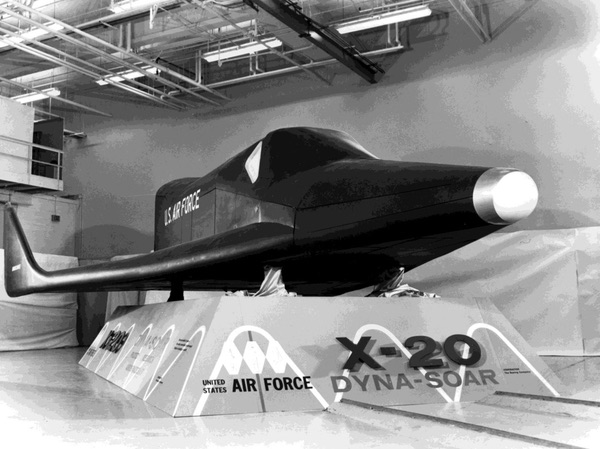 Figure 1: Mock-up of the Air Force Dyna-Soar spaceplane introduced in Las Vegas. (credit: USAF) |
With the nation’s intense interest in space due to the growing arms race with ballistic missiles, the first satellites, and plans for the first human space missions, getting to space with something resembling normal aircraft-like commercial flight operations was a hot topic within the aerospace community. Starting in 1957, the Air Force sponsored conceptual design studies of single-stage and two-stage aerospace planes capable of achieving orbit after taking off from a runway. This effort spawned a large number of spaceplane concepts throughout industry and the government. The aerospace plane studies identified that substantial technology development was still needed. These became the focus of government and industry R&D, such as the development of scramjet propulsion.
| Throughout the Eisenhower, Kennedy, and Johnson administrations, human military spaceflight was shunned. Fortunately, as spaceplane technologies advanced, new Air Force leadership reopened this closed door just a decade later. |
A couple of years after Dyna-Soar was cancelled, film director Stanley Kubrick began to develop the classic science fiction movie 2001: A Space Odyssey. Based on a short story by Arthur C. Clarke, it was a bold, technology-focused look intending to convey what our spacefaring future could be by 2001. Kubrick enlisted aerospace experts to make his movie as technically correct as possible. For example, memos were written about how the hibernation of the astronauts would be done. Highly realistic sets and models were developed with a substantial focus on minute details that are barely visible in the film.
After a long sequence setting the premise for the plot, the shift to the future of 2001 opens in Earth orbit. A commercial spaceliner is approaching a large, partially constructed, rotating space station. Dr. Heywood Floyd is the lone passenger in what appears to be a fairly conventional passenger compartment. He is asleep, indicating that the travel to space, at least for Dr. Floyd is just another routine business trip.
The spaceliner is the Orion III. I use it in these articles to illustrate what commercial passenger spaceflight should look like. The movie’s fictional Orion III was conceived in 1966 as a TSTO spaceflight system. Although not shown in the movie, it was ramp-launched with the 175-ft long Orion III spaceliner mounted atop a nearly identical Orion I first-stage booster. The two stages separated at Mach 14 with the spaceliner continuing to orbit, as seen in the movie. Noting that Kubrick called upon expertise from across the aerospace industry, the “design” of the Orion III appears to have benefitted from some engineering thinking. A 3-D model of the Orion III is shown below.
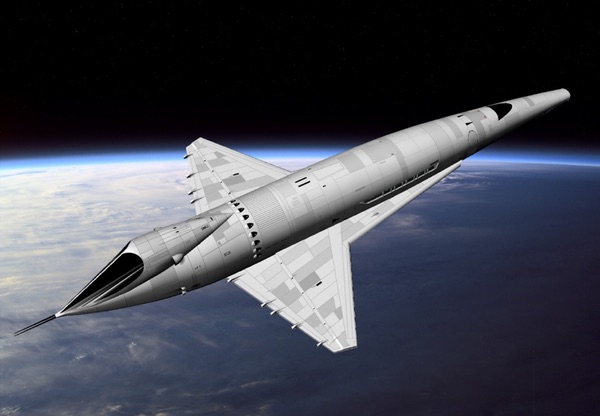 Figure 2: Orion III spaceliner from the movie 2001: A Space Odyssey. (Model credit: B. J. West. Illustration credit: J. M. Snead) |
The Orion III would hold 30 passengers and a crew of three. Assuming an average of 250 pounds (1113 kilograms) for the crew and passengers—passenger, baggage, and incidentals—the net payload weight would be 8,250 pounds (3740 kilograms) delivered to the space station.
Air Force interest in human military spaceflight returns
In late 1963, the politically struggling Dyna-Soar program was abruptly cancelled by the new Johnson administration just two weeks after President Kennedy was assassinated. The stated reason was that Dyna-Soar duplicated NASA’s human spaceflight efforts, satellite-based reconnaissance, and ICBMs for nuclear weapon delivery. Throughout the Eisenhower, Kennedy, and Johnson administrations, human military spaceflight was shunned. Fortunately, as spaceplane technologies advanced, new Air Force leadership reopened this closed door just a decade later. As I recall, the illustration below was on the cover of Airman magazine in the 1970s. Note the “U.S. Aerospace Force” on the S-17 military spaceplane. (Since the 1960s, the “S” designation has been listed for use for spaceplanes.)
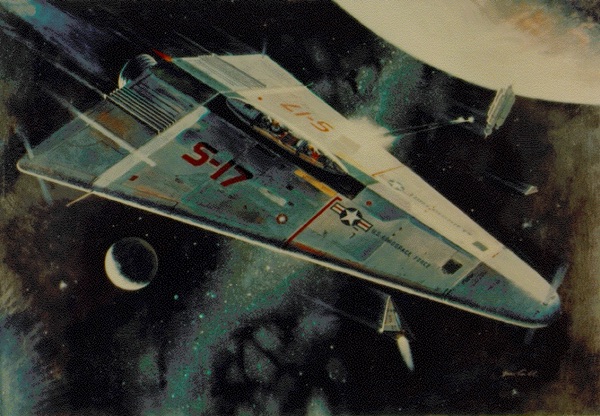 Figure 3: Air Force wall art of S-17 U.S. Aerospace Force spaceplanes. (credit: USAF) |
Boeing’s Reusable Aerodynamic Space Vehicle
As mentioned in Part 2, the need to develop more aircraft-like space access was well understood in the late 1960s. Throwing expensive rockets into the sea would not open the space frontier to routine access. A Vice President-led committee proposed that a fully-reusable, TSTO VTHL system be developed by NASA. Politics and budget cutting turned this into the partially-reusable/refurbishable Space Shuttle. Its cumbersome and expensive operations prevented it from becoming the “DC-3” opening space as intended.
At the same time that NASA was beginning the development of the Space Shuttle in the early 1970s, the Air Force again began to explore the roles and missions of human military spaceflight. Surprisingly, this was initiated by the “space” side of the Air Force, who had historically opposed human military spaceflight. One of these explorations was with Boeing, looking at military aircraft-like SSTO horizontal-takeoff, horizontal-landing (HTHL) concepts. By the end of 1974, through Boeing Independent R&D, the Reusable Aerodynamic Space Vehicle (RASV) concept was defined.
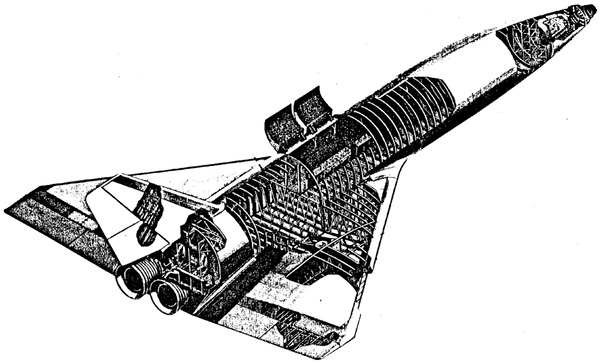 Figure 4:Structural design of the Boeing Reusable Aerodynamic Space Vehicle. (creidt: USAF) |
Boeing’s conceptual design engineers had developed a hot structures design that would take off and land on a runway. (A “hot structures” design does not have a separate thermal protection system over most of the airfame but, instead, uses high-temperature materials. This was how the Boeing Dyna-Soar spaceplane was designed.) Two Space Shuttle Main Engines (SSME) were used on the spaceplane. Takeoff would use a large SSME-powered sled, from which the spaceplane would separate at 400 miles per hour (640 kilometers per hour) after a ground roll of a little over a mile. (The use of a takeoff-assist is what makes this a quasi-SSTO concept.) After liftoff, the spaceplane would accelerate to orbit while the sled would be decelerated on the runway in about 7,000 feet (2,160 meters); a jet pack could be used in place of the sled to ferry the spaceplane. After liftoff, the spaceplane would execute an aerodynamic turn to the desired heading before accelerating to orbit or, for many military missions, completing only a once-around flight. The net payload capability to a low orbit, without an aerodynamic turn, was around 20,000 pounds (9,070 kilograms), depending on the amount of on-orbit maneuvering required.
| Throughout the Eisenhower, Kennedy, and Johnson administrations, human military spaceflight was shunned. Fortunately, as spaceplane technologies advanced, new Air Force leadership reopened this closed door just a decade later. |
In today’s dollars, the recurring operational cost was estimated to be about $4 million at a flight rate of 25 flights per year for the fleet. Yes, $4 million or about $200 a pound! The estimated program cost through the production of four flight units, in today’s dollars, was $14 billion, taking about eight years. In 1979, the Boeing president offered to build a prototype RASV for about $4 billion in today’s dollars.
In 1979, the Acting Secretary of the Air Force, in a memorandum to the Air Force Chief of Staff (the service’s senior four-star general officer), wrote about the RASV:
I have been interested in the Reusable Aerodynamic Space Vehicle (RASV) concept for a number of years. Such a single-stage-to-orbit system has the potential of providing us with a manned platform that can be over any point on earth in less than a hour. The RASV could perform a wide variety of very important missions, including reconnaissance, rapid satellite replacement and space defense to name just a few.
I would like to express my continuing support for the RASV efforts. As you know, both SAC [Strategic Air Command] and ADCOM [Aerospace Defense Command] have already addressed RASV requirements. In addition, I believe we have invested about $225K prior to FY 79, and plan to spend about $1M this year and $2M in FY 80 for RASV. Although the technology has a ways to go, I believe the potential benefits of such a system warrant this level of effort. I hope you will give this program your support as well.
In short, the potential of human military spaceflight was again officially on the service’s radar. The “air” side of the Air Force jumped at the opportunity to pursue human manned spaceflight.
Transatmospheric Vehicles at Wright-Patt
At the end of the 1970s, with renewed senior-level interest in human military space access, the various Air Force laboratories, system development organizations, and operating commands began to undertake needed studies and map out possible future acquisition plans. It is not possible, unlike in some privately held companies, for the Air Force Secretary to snap his or her fingers and start a major new weapon system acquisition. It takes several years of effort to reach the point where a technically defendable proposal to develop a new weapon system can be presented to Congress as part of the service’s proposed future budget. This preparatory work is called development planning.
| After the name sensitivity became apparent, the name “Transatmospheric Vehicle” or TAV was invented. It did not use space, spaceplane, or shuttle, but it correctly identified the intended operational characteristics of the system much as do the generic names “bomber” and “fighter.” |
With the RASV seeking to achieve aircraft-like operations with a system that was, essentially, an advanced aircraft, the Air Force’s Aeronautical Systems Division (ASD), located at Wright-Patt near Dayton, Ohio, acted on the Acting Secretary’s interest to begin studies in 1979. ASD was one of the divisions of the Air Force Systems Command (AFSC) which was responsible for managing the acquisition of new Air Force weapon systems. Another AFSC division, Space Division (SD), acquired ballistic missiles, expendable launch vehicles, and satellites. (SD had initiated the RASV study.) At that time, in addition to many smaller programs, ASD was managing the acquisition of the F-22, C-17, and B-2.
In early 1983, as ASD was about to issue short-term study contracts to define useful solutions, SD’s sensitivity to ASD’s focus on space access became apparent and a political hot potato. Especially, they opposed any use of “space” in the title such as in “spaceplane”. After the name sensitivity became apparent, the name “Transatmospheric Vehicle” or TAV was invented. It did not use space, spaceplane, or shuttle, but it correctly identified the intended operational characteristics of the system much as do the generic names “bomber” and “fighter.” In late 1983, ASD’s Deputy for Development Planning wrote:
We believe the Transatmospheric Vehicle Program is a unique potential application of atmospheric and exoatmospheric (space) capabilities. The thrust of our ongoing TAV investigation is to predict, project, and evaluate military missions for this type of system. Once established, these missions will be translated into conceptual TAV systems that use the latest in technology advancements and projections. An evaluation will be conducted into the merit of these conceptual TAV designs against alternative system applications.
In May 1983, ASD released $1.6 million in today’s dollars for Phase 1 study contracts to define TAV concepts. The dollar amount of these initial contracts is usually low, with the contractors often investing company funds in the efforts. What is important to the contractors is that the Government is expressing official interest in possibly acquiring a new weapon system that would be a major new source of income. Multiple contractors submitted concepts by the end of 1983 and the ASD development planners evaluated these during the first part of 1984.
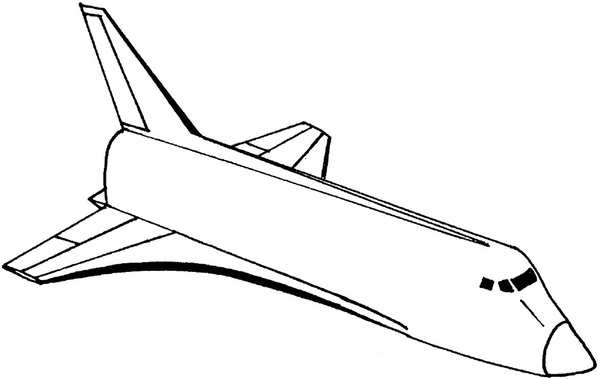 Figure 5: Lockheed quasi-SSTO TAV concept from 1983. (credit: USAF) |
Several quasi-single-stage-to-orbit (SSTO) concepts were submitted, including the RASV. All were found to have technical and operational issues. The Lockheed concept, for example, required a short-duration solid rocket booster capable of producing in the ballpark of two million pounds of thrust to lift the TAV off its launch stand and accelerate it to a minimum safe flight speed and altitude. This was impractical—operationally unsuitable—for routine military airfield operations.
The RASV also had several identified issues that removed it from consideration. Among these was the need to accelerate to 400 miles per hour for liftoff. This was substantially faster than the takeoff speed of most aircraft. The need to start four SSMEs on the ground was also a concern.
Boeing’s TSTO TAV
Besides the RASV, Boeing submitted two other TAV concepts. One, very similar to the Dyna-Soar spaceplane, used an expendable external tank to carry the propellants. It would be air-launched from the top of a Boeing 747, much as NASA used a 747 to release the Space Shuttle Enterprise during unpowered landing tests. This was also not a practical operational system.
Fortunately, a two-stage-to-orbit (TSTO) TAV concept was also proposed by Boeing that was operationally suitable with good performance. From a design perspective, it was a “sweet” design. In 1984, Boeing filed for and, in 1989, received U.S. patent 4,802,639 for this concept.
As shown in the illustrations below, the Boeing TSTO TAV uses a large aircraft carrying the orbiter in its belly. Mating uses a standard aircraft ground tug to tow the orbiter under the carrier aircraft. The carrier aircraft uses eight large military turbojet engines. This enables the mated vehicles to taxi under their own jet power to complete propellant loading and undertake takeoff without the use of the rocket engines. Obviously, this approach has minimal ground support requirements compared to a traditional vertically-launched large rocket. Also, the carrier aircraft would be used to ferry the orbiter as needed and used to airdrop the orbiter during developmental testing. As shown in the patent, the carrier aircraft can also be used to launch experimental aircraft carried in place of the orbiter. (Another series of illustrations is here.)
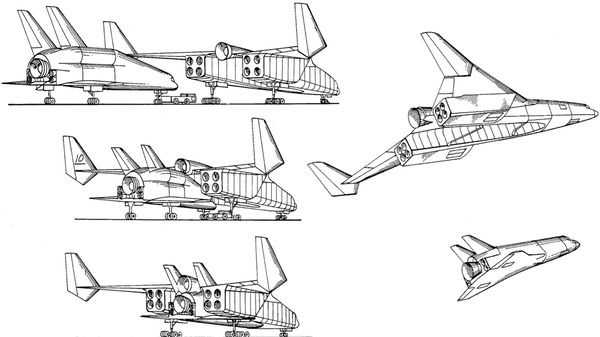 Figure 6: Cleaned up illustrations from the Boeing patent of the TSTO TAV orbiter mating (left) and separation (right). These illustrations show the -111 orbiter configuration. (credit: J. M. snead.) |
| If the fleet has 20 spaceliners and 30 spacelifters, 4,000 passengers and 3,000 tons of cargo could be transported to LEO each year. Clearly, such a commercial spaceflight system would need to be airworthiness certified. |
The flight profile is shown below. The mated systems take off under airbreathing power, climbing to 30,000 feet (9,140 meters) altitude. To begin the ascent to orbit, the two SSMEs ignite and the mated systems begin a zoom climb to 103,800 feet (31,640 meters) and Mach 3.3, where the orbiter is released. (These Mach 3 flight conditions are less severe due to the higher altitude than that experienced by the SR-71 or the XB-70.) The orbiter continues to climb and accelerate to orbital conditions while the carrier aircraft returns to the airfield under airbreathing power. Once the orbital mission was completed, the orbiter would re-enter and land unpowered as the Space Shuttle orbiter did.
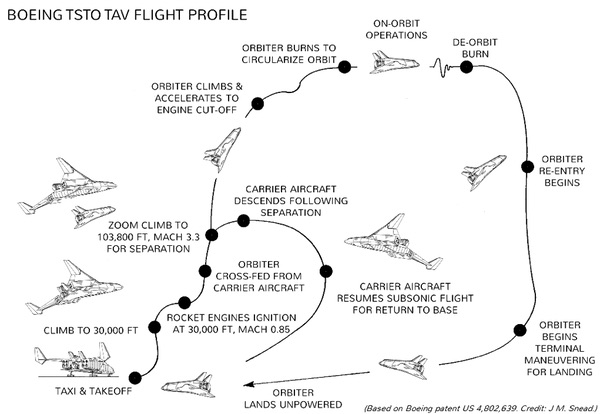 Figure 7: Boeing TSTO TAV flight profile illustration based on the Boeing patent. (credit: J. M. Snead) |
Boeing configured two orbiters to be carried by the same carrier aircraft. The -111 orbiter used a hot structures approach similar to RASV. The -112 orbiter used a cool structures approach with an external passive thermal protection system such as was used on the Space Shuttle. Both are about the same size as the Space Shuttle orbiter. The -111 orbiter has a payload bay, 11 feet (3.35 meters) in diameter by 21 feet (6.4 meters) in length. A payload up to 30,000 pounds (13,600 kilograms) could be carried on a once-around mission due east, with minimal fuel for orbital maneuvering. For an orbital mission due east from the Kennedy Space Center to a circular orbit of 250 nautical miles (463 kilometers), the delivered payload would be around 10,000 pounds (4,530 kilograms) with a crew of two. (Of course, this system can take off from many other locations.) An orbiter configured as an uncrewed spacelifter would have a somewhat larger payload capability. Note that these performance estimates are 35 years old indicating that better performance may be achievable today with updated analyses.
In 1983, Boeing estimated an initial operational capability being achieved in 1995—before 2001! The estimated development and acquisition cost for 50 orbiters and an appropriate number of carrier aircraft was $62 billion in today’s dollars. A 20-year operational and support cost for a total of 2,000 missions was $16 billion in today’s dollars or $8 million per mission. The return payload would be 5,000 pounds (2,270 kilograms), or about ten passengers and three crew, with the orbiter configured as a spaceliner. A passenger ticket would then be about $2 million. Later analysis indicated that a 50-orbiter fleet could support in the ballpark of 1,000 missions per year. If the fleet has 20 spaceliners and 30 spacelifters, 4,000 passengers and 3,000 tons of cargo could be transported to LEO each year. Clearly, such a commercial spaceflight system would need to be airworthiness certified.
The illustrations below are of the -112 orbiter, which would have a Shuttle and X-37-style thermal protection system (TPS). In the 1983 trade study, with the carrier aircraft being primarily sized to the -111 orbiter, the -112 orbiter loses some useable propellant volume due to the TPS. This reduced the payload performance by about 25 percent. These were, of course, very preliminary estimates, 35 years ago.
The internal arrangement is very straightforward, with a ring-frame-supported liquid hydrogen tank forward and two liquid oxygen (LOX) tanks mounted aft under the payload bay. Structural frames transfer the payload and LOX inertia loads into the primary structure. A single SSME, with an altitude compensating moveable nozzle, and two RL10-type engines are mounted at the rear.
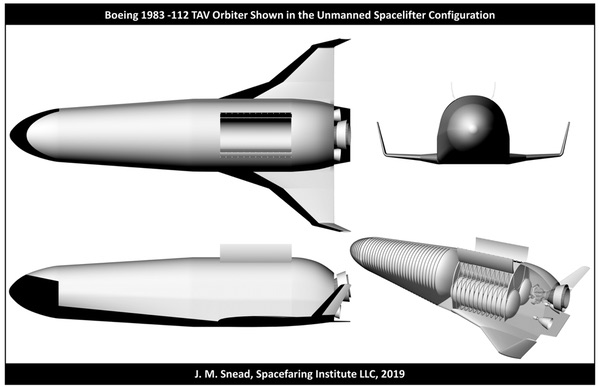 Figure 8: Boeing 1983 -112 TAV orbiter in the unmanned spacelifter configuration. (credit: J. M. Snead) |
TAV technology readiness assessment
I joined the small TAV project office 35 years ago as the “project engineer.” My primary role was to interface with the Air Force labs and the ASD engineering directorate—my home office—and to lead the formal “tech eval” to determine industry’s readiness to proceed into full-scale engineering development. This “tech eval” was done per the guidance of a General Officer Steering Group and involved about 60 Air Force engineering and scientific experts. If the tech eval and associated reviews indicated that industry was ready to proceed, that all requisite critical path technologies were sufficiently mature, and that the general class of solutions satisfactorily addressed a valid operational shortfall or identified threat, a new weapon system development effort would be recommended with requested funding. ASD used this same process prior to starting its F-22, B-2, and C-17 programs then underway.
The Boeing TSTO TAV concept was used as the baseline for this assessment. In the late summer of 1985, based on the completed tech eval and other considerations, ASD formally recommended establishing a system program office, programming needed development funds, and initiating full-scale engineering development of a TSTO crewed capability.
In 1992, as I just recently found out, Boeing engineers updated the TSTO design and performance analysis. This was published in the AIAA 93-4161 technical conference paper, “A Reusable Two Stage Launch System”. Expressing conclusions similar to those from the ASD 1985 tech eval, the Boeing 1993 paper’s summary states:The TSTO approach as described herein, exhibits significant potential benefits to the space access/transportation capability by offering system features which are prerequisite to long term affordability and utility. Principal among these tangible benefits are:
- Full reusability of flight hardware – no expendable or recurring flight hardware required.
- Two-stage efficiency – designed in margins/derating for life cycle reliability/growth.
- Airplane type infrastructure – efficient launch processing, increased basing flexibility.
- Jet powered horizontal takeoff and landing – offset launch, mission recall.
The decision whether to start a major weapon system development comes from a complex mix of funding, politics, and Air Force/DoD/Congressional priorities. AFSC declined to support a new program start, ending the TAV effort in the late summer of 1985. Shortly thereafter, the National Aerospace Plane (NASP) SSTO program was started based on presidential direction. The NASP/X-30 program was to build an experimental aircraft to conduct research flights at high Mach numbers with the goal of being able to achieve orbit using a single stage. The X-30 program ended in the early 1990s when the inability to confidently predict high Mach number scramjet performance made finalizing the design impossible. By the time NASP ended, TAVs would have been nearing flight.
| From my perspective, this Boeing spaceplane is an engineering test bed for the TSTO TAV orbiter. |
The takeaway is that, in 1985, industry was judged ready to begin developing a fully-reusable TSTO system, possibly becoming operational prior to 2001. The very public emergence of the National Aerospace Plane program in late 1985, followed in early 1986 by the loss of the Space Shuttle Challenger, rapidly swept aside the TAV study results. Very little about this effort was recorded in permanent Air Force historical reports. While Boeing had filed for a patent while the TAV study was underway, this would not be published until 1989. Unaware of the patent filing, for 20 years I assumed the concept was proprietary until I found the patent around 2007. Government employees are not permitted to divulge company proprietary information.
The illustration below shows the fictional Orion III spaceliner with the spacelifter configuration of the Boeing -112 TAV orbiter.
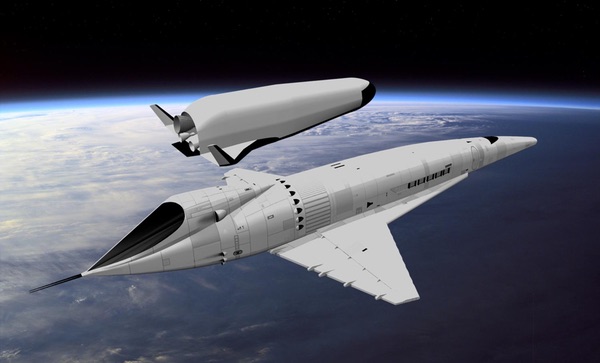 Figure 9: The 175-ft long fictional Orion III spaceliner and the 114-ft long conceptual Boeing TAV -112 orbiter are shown to the same scale. The TAV orbiter would have two versions: an unmanned cargo spacelifter and a passenger spaceliner. (credit: J. M. Snead) |
Boeing’s recent spaceplane efforts
My recent inquiries with Boeing found that they had completely forgotten about the TSTO concept and had no records of it. However, Boeing has been involved with two relevant efforts—the X-37 and X-40 spaceplanes and the DARPA Experimental Spaceplane.
In 1998, Boeing built the X-40A Space Maneuver Vehicle to perform drop tests of a small, uncrewed spaceplane. This was followed by the X-37B Orbital Test Vehicle that has now been launched five times into space performing long-duration missions. The spaceplane configuration enables an unpowered landing similar to that baselined with the Dyna-Soar spaceplane and used by the Space Shuttle orbiter. The X-37B, along with the Space Shuttle orbiter, validate that unpowered landings can be used for normal operations and that passive thermal protection systems are adequate. The X-37B is launched atop a large rocket within a protective shroud.
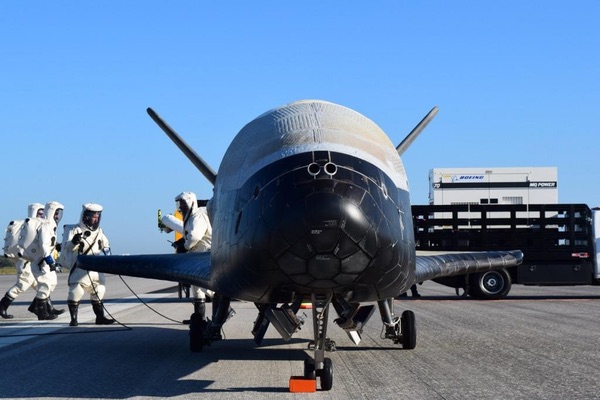 Figure 10: Boeing X-37B after landing. (creit: USAF) |
Boeing is also developing the DARPA Experimental Spaceplane. This is to demonstrate, by flight test, the practicality of a fully-reusable first stage capable of achieving around Mach 10 during its ascent prior to releasing an expendable rocket-boosted second stage.
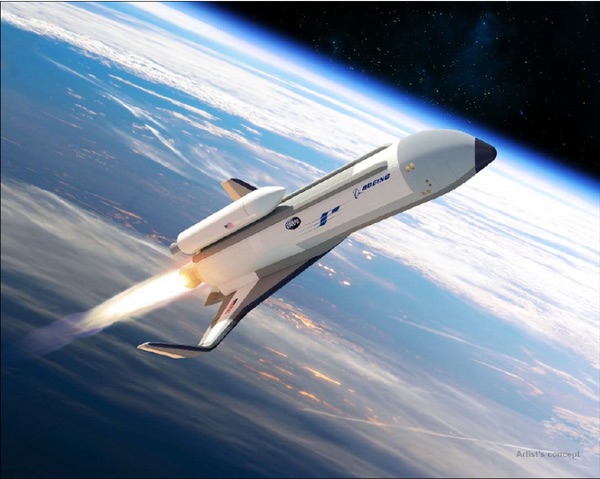 Figure 11: Boeing Experimental Spaceplane. (credit: DARPA) |
Boeing’s design incorporates a modified SSME as the primary propulsion system. This year, a test version of the SSME was ground fired ten times over ten days to demonstrate the readiness of this engine for the flight testing. A goal of the DARPA program is to fly the spaceplane ten times over ten consecutive days.
In developing and flight testing the DARPA spaceplane, Boeing will have measured flight loads, actual installed engine performance, aerothermal loads and the airframe’s structural response, and the cryogenic liquid hydrogen/liquid oxygen propellant system performance. A validated set of avionics, guidance, communication, and telemetry systems will have been demonstrated. Most importantly, the mass property engineers will have actual versus predicted mass properties improving the accuracy of future preliminary design efforts. Similarly, the system planners will have actual versus predicted manufacturing costs and schedules.
From my perspective, this Boeing spaceplane is an engineering test bed for the TSTO TAV orbiter. When combined with the operational experience from the Space Shuttle orbiter and the X-37B spaceplane, the engineering development risk of the Boeing TSTO TAV is being substantially reduced. We now have an opportunity to shorten the development time and reduce the development risk of commercial spaceliners and spacelifters that should not be ignored!
Airworthiness, suitability, and effectiveness considerations
Little information has been released about the two spaceplane efforts. Hence, I have no understanding of what airworthiness criteria may have been imposed on their designs. My expectation is that little, if any, safety-related criteria was required other than that associated with the handling of the spaceplanes on the ground and range safety for spaceplanes during flight.
| With one change, what we should have done in 1985 is what we now need to do to jumpstart an American commercial passenger spaceflight industry. |
Had Wright-Patt led the development of the Boeing TSTO TAV system in the 1980s, operational safety (airworthiness), suitability, and effectiveness would have been baked into the program from the outset as is done for all Air Force aircraft. Military aircraft are required to be airworthiness certified because they usually carry crew and passengers but also because some carry weapons, including nuclear weapons. Hence, operational safety is the foundation when a new flight system is being developed. To ensure that the new system meets the using command’s needs and is financially affordable to operate, suitability and effectiveness requirements are also included. These are all factored into the program from the outset to preclude sudden “gotchas” as the program transitions from the prototype to the production and operation phases.
If the TAV program had been started as ASD recommended, achieving an initial operational capability in 1995, these military TAV systems—both the carrier aircraft and the orbiter—would have been airworthiness certified by the Air Force using a modified version of the Air Force’s military aircraft criteria. Subsequentially, a commercial version of the military system, with orbiters configured as both spacelifters and spaceliners, could have come into operation by 2001. These would have been airworthiness certified by the FAA, building on the Air Force’s airworthiness certification experience and lessons learned. With one change, what we should have done in 1985 is what we now need to do to jumpstart an American commercial passenger spaceflight industry.
How the jet age came into being
Recognizing that some will be skeptical of the approach I outline below, it is helpful to briefly look back at how America’s world-leading commercial passenger airliner industry came into being in the 1950s.
Immediately after World War II, the Air Force began a rapid transition to jet-powered aircraft. Boeing was selected to develop the jet-powered B-47 bomber. The B-47 pioneered the swept wing design for large aircraft with the jet engines mounted on pylons under the wing. This was a significant design improvement that is still standard for subsonic airliners. (Others were embedding the engines in the wing, which created safety and maintenance issues.) Jet propulsion, combined with the swept wing, enabled flight at near sonic speeds at high altitudes for long distances. Building on the B-47 success, the Air Force initiated the development of the longer-range B-52 that, after Air Force prodding, incorporated a swept wing design. Developing these two jet bombers at government expense provided Boeing with the expertise needed to transition this swept wing jet technology to commercial airliners. The Air Force programs also developed the jet engines and other related auxiliary equipment Boeing needed.
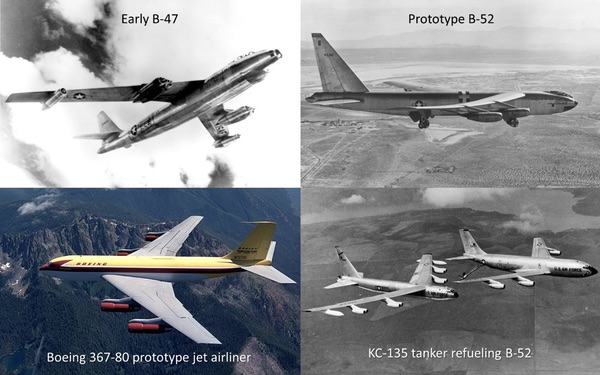 Figure 12: Development of the modern jet transport design. (credit: J. M. Snead) |
In the early 1950s, Boeing bet the company on building what became the jet-powered, swept-wing Boeing 367-80 prototype, where the “-80” indicated the 80th design iteration. (Publicly, this was referred to as the 707 prototype.) The prototype aircraft, fitted with a refueling boom, was demonstrated to the Air Force. Having the need for a new jet tanker to keep up with the jet bombers, the Air Force quickly placed an order for what became the KC-135. Boeing used their growing jet-powered design and manufacturing expertise in building the KC-135 to quickly produce the very similar final design of the Boeing 707 jet airliner. Along with the Douglas DC-8, these two airliners ushered in the jet age at the end of 1957. The first 707 flew the New York City to London route. It did not fly with an empty seat for six months; such was the demand for the speed and comfort of jet travel.
The B-47, B-52, and KC-135 were airworthiness certified by the military per the requirements of that time. Their demonstrated airworthiness—resolving lingering concerns about the safety of jet travel—provided the basis for the FAA’s development of its new jet airworthiness regulations and certification requirements. This military jet “track record” enabled the 707 and DC-8 to quickly enter commercial service.
While the B-47 and B-52 were weapon systems with true war-fighting capabilities, the KC-135 was essentially a passenger/cargo aircraft with the added ability to refuel military aircraft. It did not have warfighting capabilities beyond airlift and air refueling. Hence, just as was demonstrated with the -80 prototype, the KC-135 could have been developed as a dual-use aircraft with military versions delivered with a refueling boom and commercial airliner versions delivered without the boom. The further feasibility of this approach is seen today with the “new” Air Force KC-46 tanker that is a Boeing 767 commercial airliner with an added refueling capability. With one difference, the successful and rapid development of jet-powered large aircraft provides the model to now use to bring an American commercial passenger spaceflight industry into being. The one difference is that such a system would not be acquired by the Air Force as a military weapon system but through a new civilian port authority.
Establish a civilian astrologistics port authority
With the 1926 Air Commerce Act, besides airworthiness, the US government also undertook to license pilots, establish air traffic rules, establish airways, and operate and maintain aids to navigation. In 1936, the government took over operations of several major air traffic centers established by airline operators. In 1938, the government took over accident investigations to make sure that the airworthiness of the operating fleets was maintained and that lessons learned from accidents were integrated back into the approved engineering and operating principles and practices. Just prior to World War II, the government took over the control towers at the airports. The FAA was formed in 1958 as the jet age took hold. A retired Air Force general became the first FAA administrator. Overall, beginning in 1926, the Us government led the establishment of an integrated air-faring logistics infrastructure that continues to serve Americans very well.
For America to become a true commercial human spacefaring nation, an integrated human spacefaring logistics infrastructure—what I refer to as astrologistics—will be needed. Despite having spent nearly $1.2 trillion (FY2020 dollars) since 1958, everyone now realizes that NASA has failed to meet this need. The reality is that NASA, through its congressional funding, has other priorities such as returning Americans to the Moon. Port authorities have long been used to build government-funded and government-sponsored infrastructure. A civilian astrologistics port authority—with initial military engineering management assistance—is now needed.
| When federal employees, military personnel, and even astronauts fly on routine duty, how do they travel? On commercial airliners. The same will be true when commercial passenger spaceflight service to LEO is established. |
The military has been involved in many major infrastructure projects as most meet important dual-use needs. In 1956, Congress passed the National Interstate and Defense Highways Act. Military logistics needs were integrated into the design of the system, including connecting the highways to the major Air Force bases. Also, some defense funds were initially redirected to help start construction. When building the Panama Canal was taken over by the United States, a US Army Corps of Engineers officer led most of the construction of the canal even though it was a civilian project. Military space needs are now being integrated into commercial space systems. And, as we all know, the military’s Global Positioning System has become a vital part of world commerce—built despite the Air Force leadership’s initial opposition.
An integrated astrologistics infrastructure will have many elements, including transportation, communication, navigation, energy, life support, medical care, housing, materiel storage, operations oversight, emergency response, and law enforcement. Some of these elements, such as communication and navigation, are already in place. Private industry now provides an initial medium and heavy uncrewed cargo transport capability, while the Space Launch System will provide a vital uncrewed super-heavy and oversize spacelift capability.
The immediate astrologistics need is for a non-warfighting mission capability to perform passenger transport and cargo spacelift. Hence, the logical initial responsibility of the astrologistics port authority is to undertake the acquisition of airworthiness certified passenger spaceliners and cargo spacelifters to provide commercial service to and from LEO. Drawing on the KC-135 and KC-46 examples, the first-generation spaceliners would serve the needs of civilian commerce as well as the military, NASA, and other federal agencies. When federal employees, military personnel, and even astronauts fly on routine duty, how do they travel? On commercial airliners. The same will be true when commercial passenger spaceflight service to LEO is established.
Locate the astrologistics port authority near Dayton, Ohio
Port authorities build many types of infrastructure: airports and seaports, tunnels and bridges, highways and rail systems, power generation facilities, and more. In acquiring these capabilities, operational safety is but one consideration as the new infrastructure must also be useful (suitable) and affordable (effective). Therefore, when acquiring first-generation spaceliners and spacelifters, besides airworthiness, the port authority will also need to focus on suitability and effectiveness to ensure that acceptable systems are delivered.
The port authority will need a sound systems management methodology and the requisite experience and expertise to manage the contracts. There is no reason to start with the proverbial clean sheet of paper. Following the historical example of the development of jet air travel, organizing the acquisition using the Air Force’s approach to achieving operational safety, suitability, and effectiveness should be used. NASA’s” human-rated” approach to safety is substantially deficient for ethical commercial use, as was previously discussed, while the FAA does not acquire capability. This means that the systems engineering and management expertise resident at Wright-Patt must be tapped as no other government organization has the requisite airworthiness and large human flight system acquisition expertise.
I propose that a new federal port authority—perhaps organized as a Federal Government Corporation—be established off base near Dayton, Ohio, to lead the development and acquisition of these new human spaceflight capabilities. Just as happened with the founding of NASA, military and civilian personnel from Wright-Patt would be initially collocated to the new organization to provide most of the initial technical and management staff. Being located close to Dayton, this will not require travel or moving expenses and family disruptions, enabling the initial functions of the organization to begin quickly. This will also enable the highly experienced retired aerospace personnel resident in the Dayton area to be enlisted in this effort.
| Within perhaps a decade, America can be on a firm path to becoming a true commercial human spacefaring nation. |
Over time, many of the port authority’s personnel will be hired separately. However, my expectation is that a continuing rotational assignment of Wright-Patt personnel will prove advantageous to expand and update the Air Force’s organic experience and expertise with these new spacefaring capabilities. Eventually, the US Space Force will need its own crewed spaceliners and spaceships. Wright-Patt would be the logical source of the technical and management expertise to acquire these airworthiness-certified Space Force operational capabilities just as it does for all Air Force aircraft.
Spaceward Ho!
Thirty-five years ago, Wright-Patt believed that a HTHL TSTO TAV system was sufficiently technically mature to begin full-scale engineering development. Developing HTHL TSTO commercial spaceliners would be the first operational capability that the new astrologistics port authority would pursue with other astrologistics capabilities to follow. Wright-Patt’s approach—not NASA’s “human-rated” approach—to operational safety, suitability, and effectiveness would be tailored to these efforts. Wright-Patt, in conjunction with the FAA, would provide the independent airworthiness certification of the prototype flight systems with the FAA providing the final production type certificate and airworthiness certification. These initial spaceliners and spacelifters would be leased to commercial spaceflight companies with the stipulation that military missions using reserve officer flight crews could be conducted. Additional spaceliners and spacelifters of the same type design could be sold directly to these companies as demand grew.
Within perhaps a decade, America can be on a firm path to becoming a true commercial human spacefaring nation. A robust and expanding American spacefaring industrial base would be meeting our growing commercial and governmental passenger and cargo spaceflight needs. Commercial passenger spaceflight would expand into permanent LEO astrologistics operations with true spaceships navigating Earth-Moon space. America would finally be moving boldly spaceward! Our national struggle to solve the commercial passenger spaceflight puzzle would be permanently behind us with a dazzling spacefaring future ahead.
The president of the Air Force Association, Lt. Gen. Bruce “Orville” Wright, (USAF, ret.), recently released his “President’s Perspective” on the Air Force-Space Force political wrestling match in Congress. He advocates for a Space Force within the Air Force.
Hence, there may be a time in the future to rename our long-established and proven Department of the Air Force as the Department of the US Air and Space Forces or Aerospace Force, to underscore the importance of both domains. Together, this air and space team would operate from, through and in the air and space domains.
Recalling the earlier nearly 40-year-old illustration of an Aerospace Force S-17, Gen. Wright raises this possibility:
THE NEED FOR A MANNED COMBAT SPACE PLANE
Our Space Force Airmen will also have the opportunity to fly the combat space plane force that must be a future leading-edge deterrent capability of the new Space Force. Our enemies cannot be allowed to field such capability before we do. While debates over manned or unmanned space planes will continue, one central fact remains. The human brain is not reliant on the electromagnetic spectrum to make life and death decisions and cannot be jammed. More important, neuroscientists tell us that only the human cerebrum can rapidly make the transition from ruthlessness to compassion within the demands of combat operations. With the power of space-based weapons and worldwide strategic consequences looming in our future, we must keep the reliability of manned, not just unmanned, combat space planes in our planning, research and development.
Gen. Wright anticipates the need for future human military spaceflight capabilities. As I discussed earlier, these will necessarily be airworthiness-certified military flight systems, placing the acquisition responsibility of such systems clearly with Wright-Patt. Establishing an Astrologistics Port Authority in the Dayton area to acquire the initial commercial TSTO systems, with the close-by assistance of Wright-Patt managers, engineers, and scientists, will strengthen Wright-Patt’s capabilities, when the need arises, to more effectively acquire crewed combat space planes, other human military spaceflight systems, and, of course, their necessary astrologistics support. This unique public-private partnership worked well with jet travel and will also work well for ushering in true commercial passenger spaceflight while preparing for the inevitable future human spaceflight needs of the Space Force.
Endnotes
- The Rise and Fall of Dyna-Soar: A History of Air Force Hypersonic R&D, 1944–1963, Roy Franklin Houchin II, Major, USAF, 1995. This is available through DTIC.
Note: we are temporarily moderating all comments subcommitted to deal with a surge in spam.
